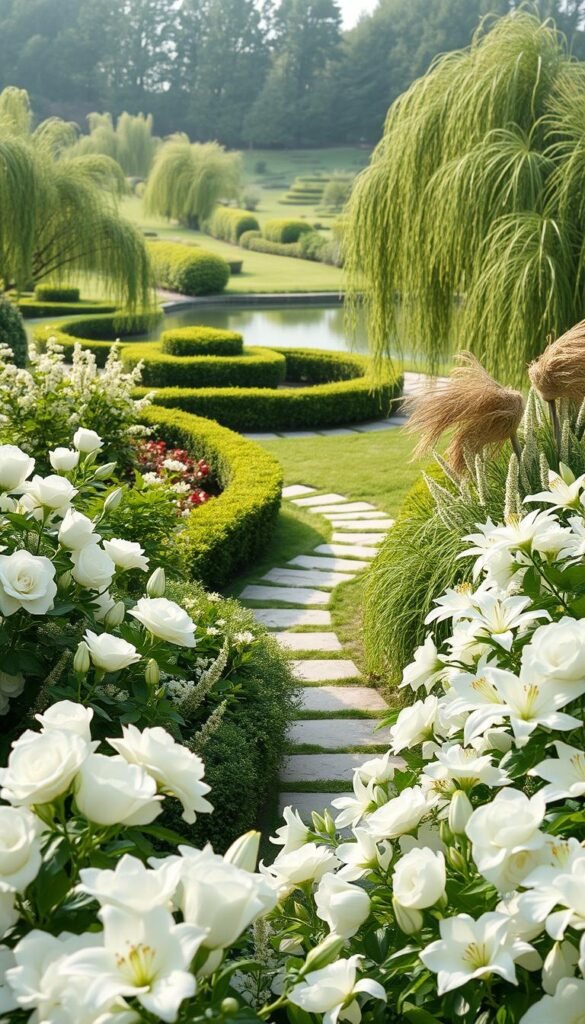Your outdoor area becomes more than just plants and soil when thoughtfully arranged. Renowned designer Scott Shrader reminds us that a property’s character begins at the curb, not the front door. This philosophy transforms ordinary yards into extensions of your home’s personality.
Amy Hovis of Eden Garden Design shares how intentional landscaping deepens emotional connections to your surroundings. Imagine returning daily to a peaceful retreat where every element works together. This harmony is exactly what how to use white in outdoor achieves through cohesive planning.
Light-toned blossoms offer more than visual calm. They highlight architectural details and create illusions of expanded space, perfect for compact areas. Varieties like Agapanthus or Philadelphus bring texture while maintaining unity.
Beyond aesthetics, this approach boosts property appeal year-round. Strategic placement ensures interest across seasons, from spring’s first buds to winter’s structural seed heads. You’ll discover how simplicity becomes sophistication when every petal plays its part.
Welcome to Your Monochromatic Garden Oasis
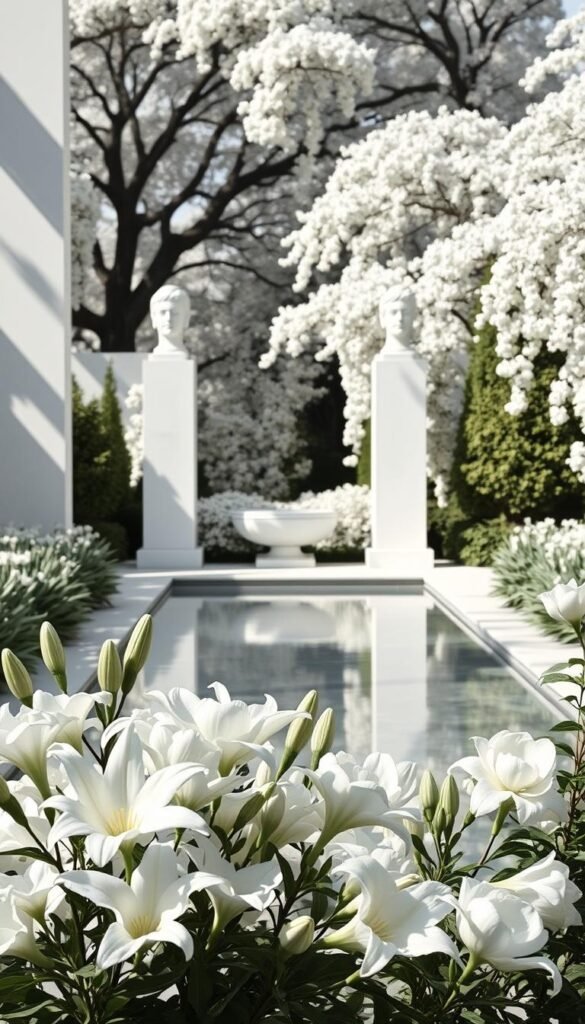
Imagine stepping into a serene retreat where every element works in harmony. Amy Hovis of Eden Garden Design emphasizes that captivating landscapes engage all five senses. Picture aromatic jasmine mingling with rustling ornamental grasses, while butterflies dance around delicate blooms. This immersive experience turns your outdoor space into a living sanctuary.
A single-color palette reveals hidden details you might otherwise miss. Crisp petals contrast with silvery foliage, while varied leaf shapes add depth. Nighttime brings magic—pale blossoms glow under moonlight, creating an ethereal atmosphere perfect for evening relaxation.
| Plant Type | Light Needs | Bloom Time | Key Features |
|---|---|---|---|
| Moonflower | Full sun | Summer nights | Fragrant nocturnal blooms |
| Snowdrop Anemone | Partial shade | Spring to fall | Drought-tolerant foliage |
| White Lupine | Full sun | Late spring | Vertical accent spikes |
Your space gains year-round appeal through strategic plant choices. Early-blooming snowdrops give way to summer phlox, followed by autumn’s seed heads dusted with frost. This layered approach maintains visual interest across seasons without overwhelming the senses.
Entertaining becomes effortless in this versatile setting. Neutral tones complement any decor style, from rustic wood benches to modern metal sculptures. You’ll find the clean backdrop highlights textural contrasts between velvety lamb’s ear and glossy camellia leaves.
White Flower Garden: Elegant Design Ideas for a Monochromatic Oasis
Creating depth in a single-color palette starts with mastering tonal variations. Ivory peonies paired with snow-white lilies add subtle contrast, while silver-edged hosta leaves introduce cool undertones. This approach keeps your yard visually engaging without relying on bold color shifts.
Texture plays a starring role in monochromatic design. Combine feathery astilbe plumes with glossy camellias to create tactile intrigue. For structure, alternate vertical spikes of white foxglove with mounding Shasta daisies. These contrasts prevent flatness in your space while maintaining cohesion.
Seasonal planning ensures year-round appeal. Try this progression:
- Early spring: Snowdrops and crocuses
- Summer: Phlox and hydrangeas
- Fall: Anemones and asters
Landscape experts at leading garden resources recommend mixing bloom shapes for dynamic interest. Star-shaped clematis flowers complement spherical viburnum clusters, while airy baby’s breath softens bold magnolia blossoms. This layered approach transforms your plants into living sculpture.
Remember to play with foliage variations. Variegated ivy or dusty miller adds pattern breaks between floral displays. Your garden becomes a study in restrained elegance, proving simplicity never means boring.
Choosing the Perfect Plants and Flowers
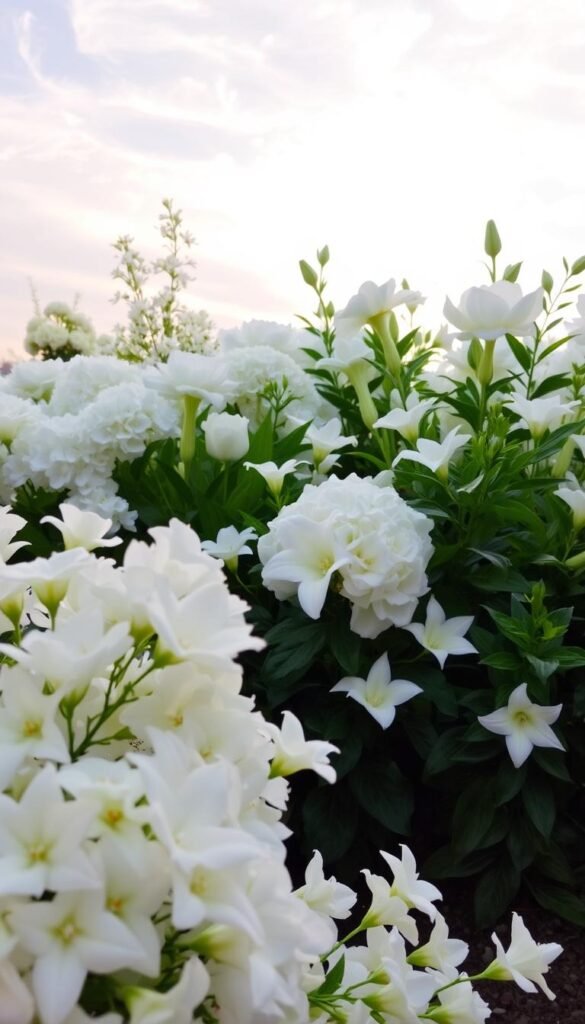
Building a cohesive plant palette starts with smart choices between reliable perennials and flexible annuals. Flowering varieties offer different benefits—some anchor your space for years, while others let you experiment with fresh looks each season.
Perennials vs. Annuals for Longevity
Cold-hardy perennials like azaleas return yearly, forming your garden’s backbone. These plants bloom once per season but require less replanting. Pair them with annual stars like petunias that flower nonstop until frost. This combo gives permanent structure and room for yearly creativity.
| Type | Lifespan | Examples | Best For |
|---|---|---|---|
| Perennials | 2+ years | Garden phlox, Hollyhock | Foundation planting |
| Annuals | 1 season | Zinnias, Dahlias | Seasonal accents |
Selecting Native Varieties
Local plants thrive with minimal fuss—they’re already adapted to your soil and climate. White wild bergamot supports butterflies, while native asters bloom late into fall. “Native species form the backbone of sustainable gardens,” notes Midwest Horticulturist Linda Jones.
Check regional guides or extension services for top picks. These flowers need less water and fight off pests naturally. You’ll create habitats for bees while enjoying low-maintenance beauty that fits your environment perfectly.
Designing Inviting Flower Beds and Arrangements
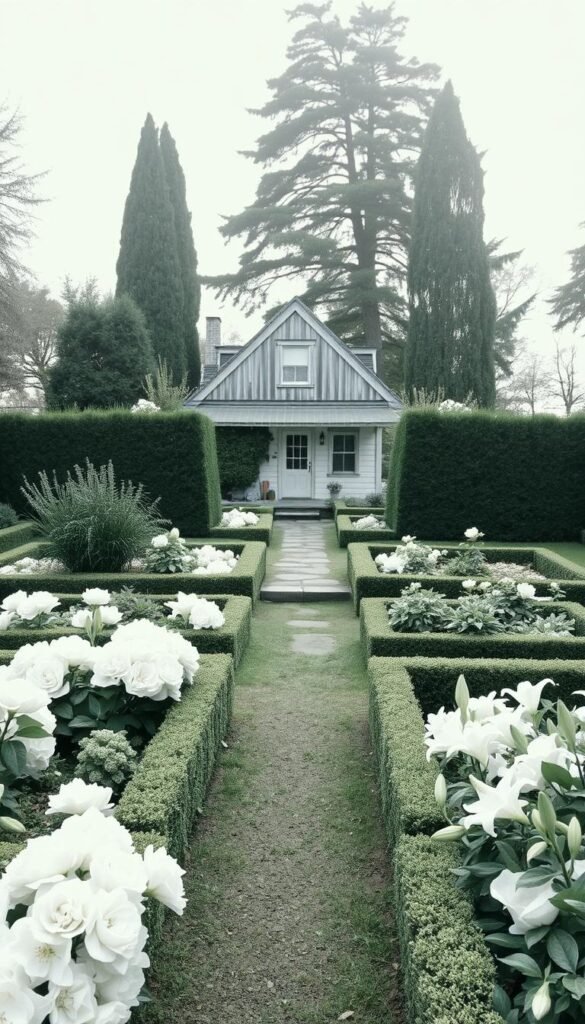
Transform your outdoor space into a welcoming retreat with cottage-style flower beds that blend romance and structure. Laura Janney, CEO of the Inspired Garden Masterclass, advises:
“Opt for dense plantings in key areas—it’s about quality over quantity.”
This approach creates immediate visual impact while keeping maintenance manageable.
Creating Structured Cottage Gardens
Start by layering heights for depth. Tall spires of hollyhocks anchor the back of your bed, while mid-height cosmos add movement. Edge with sweet alyssum for a frothy border that softens pathways. Repeat these stars throughout multiple beds to build rhythm without monotony.
| Plant Type | Height | Bloom Period | Pairing Tip |
|---|---|---|---|
| Delphiniums | 3-5 ft | Early summer | Combine with feathery astilbe |
| Foxgloves | 2-6 ft | Late spring | Underplant with creeping thyme |
| Sweet Alyssum | 3-6 in | Spring to frost | Edge walkways for fragrance |
Balance wild charm with intentional design. Leave narrow access paths between plants for easy deadheading and watering. This hidden structure lets your flowers appear effortlessly abundant while keeping care simple.
For added whimsy, weave in elements of the cottagecore aesthetic through vintage-inspired supports or curved bed shapes. Focus on condensed groupings of 5-7 perennial varieties, repeating them in drifts rather than scattering single specimens. Your flower beds become curated showcases that feel both planned and playful.
Enhancing Curb Appeal with Strategic Focal Points
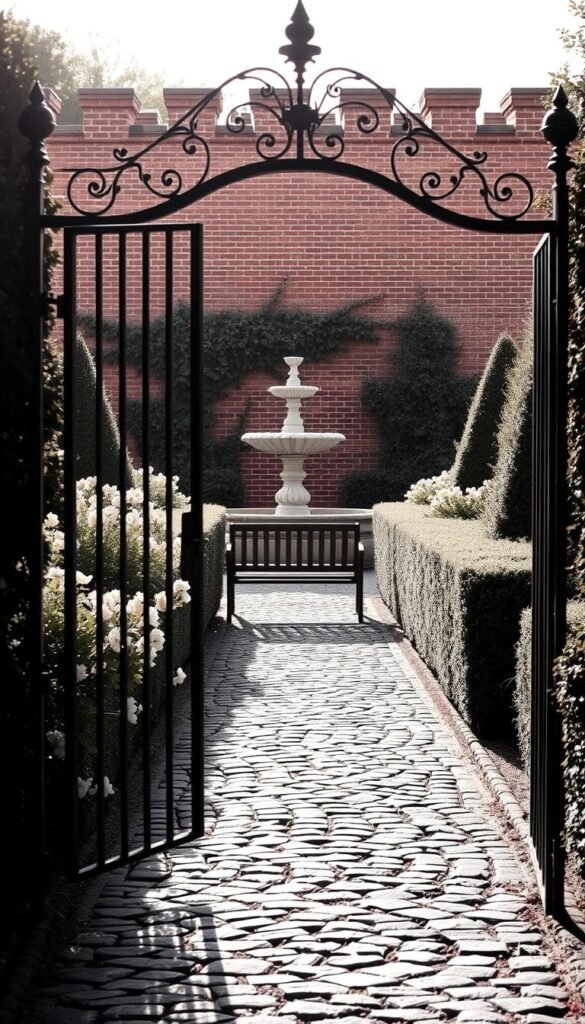
First impressions matter most when guests approach your home. Strategic planting creates instant curb appeal by guiding eyes toward your best features. Start with a showstopping white dogwood tree near the street—its spreading branches create natural framing for your house while offering year-round interest.
Layer your approach with multiple focal points at different heights. Tall magnolias near the driveway transition to mid-sized hydrangeas flanking the porch. Finish with low-growing candytuft along walkways to lead visitors toward your front door. This tiered design adds depth without clutter.
| Plant | Height | Bloom Period | Role |
|---|---|---|---|
| Dogwood | 15-25 ft | Spring | Anchor tree |
| Camellia | 6-12 ft | Winter | Entryway accent |
| Snowdrop | 3-6 in | Early spring | Pathway edging |
Frame architectural details by mirroring shapes. Place columnar arborvitae beside tall windows, then echo their lines with vertical allium blooms below. This technique makes your yard feel intentionally designed rather than randomly planted.
Rotate seasonal stars to maintain appeal year-round. Early-blooming spirea gives way to summer roses, followed by autumn sedum. Winter reveals sculptural evergreens that keep your house looking polished even under snow.
Integrating Architectural Elements into Your Landscape

Your home’s architecture deserves a landscape that speaks its design language. Geoff Valentino of Hollander Design states:
“Scale and materials should mirror your house’s character—it’s the secret to curb appeal that feels intentional.”
This harmony between built structures and nature elevates your property’s story.
Flower Bed Alignment Techniques
Match edging materials to your house’s exterior for instant cohesion. Brick-lined flower beds complement colonial facades, while sleek concrete borders suit modern homes. Repeat foundation stone types in bed borders to create visual threads connecting elements.
Entryway Enhancement Strategies
Coordinate window boxes with trim colors for a pulled-together look. Fill them with trailing lobelia and upright hydrangeas that mirror your front door’s proportions. Frame the door with matching planters holding white azaleas—their glossy leaves echo painted shutters.
Scale matters most. Place towering white lilacs beside grand entryways, but opt for dainty snowdrops near cottage-style porches. This thoughtful sizing ensures your plants highlight architectural details rather than hiding them.
Utilizing Innovative Garden Containers and Potted Plants
Containers unlock endless possibilities for shaping your outdoor space, especially when ground planting isn’t an option. Choose ceramic pots that mirror your home’s trim or introduce bold hues for contrast. This approach blends functionality with personal style, letting you refresh layouts as seasons change.
- Elevate balcony railings with hanging baskets of trailing lobelia
- Use self-watering planters for busy urban dwellers
- Stack modular vertical systems against blank walls
| Container Type | Best For | Material Benefits |
|---|---|---|
| Glazed Ceramic | Long-term displays | Retains moisture, durable |
| Concrete | Architectural accents | Weather-resistant, heavy |
| Fabric Grow Bags | Root-sensitive plants | Portable, breathable |
Create dynamic arrangements by layering heights and textures. Pair upright freesias with cascading ivy in oversized urns. For seasonal interest, swap summer petunias for autumn pansies. Rotate pots to sunny spots as light shifts—your garden stays vibrant without replanting.
Master drainage by adding gravel layers and using quality potting mix. Water morninglories deeply but less frequently to encourage strong roots. Discover more inspiration through colorful container gardening techniques that adapt beautifully to monochromatic schemes.
Your patio becomes a living canvas. Group varying pot sizes near seating areas for immersive beauty. When frost threatens, simply move delicate flowers indoors—flexibility meets elegance in every season.
Exploring Texture and Layering Techniques in Your Yard
Transform your yard into a living tapestry by playing with contrasting surfaces and dimensions. Amy Hovis reveals how combining bold shrubs with airy flowers creates instant drama. Start with structural specimens like variegated hostas—their broad leaves make perfect partners for wispy gaura blooms.
Mixing Plants, Shrubs, and Sculptural Elements
Build depth through strategic stacking. Place towering lilacs as backdrops, then layer mid-height phlox ahead. Finish with creeping thyme along edges to soften hardscapes. This tiered approach guides the eye while maximizing your yard’s potential.
Introduce year-round intrigue using non-floral elements. Birch trees add winter interest with peeling bark, while ornamental grasses sway in autumn breezes. Pair glossy camellia leaves with fuzzy lamb’s ear for tactile contrast that delights fingertips.
Remember: texture isn’t just visual. Rustling panicle hydrangeas create soundscapes, while fragrant viburnum shrubs engage multiple senses. Even simple stone benches gain significance when framed by billowy flowers and structured boxwoods.
Your space becomes a curated gallery where every plant plays a role. By balancing bold shrubs with delicate blooms and architectural elements, you craft an environment that feels both intentional and effortlessly inviting.

